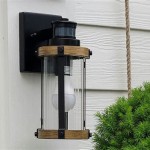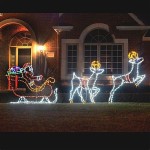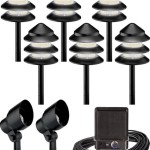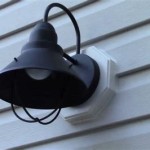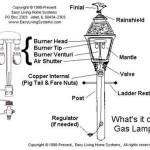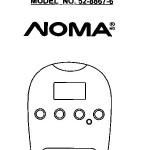Wire Size for Outdoor Lights
Selecting the correct wire size for outdoor lighting is crucial for safety and optimal performance. Using undersized wire can lead to voltage drop, overheating, and potential fire hazards. Oversized wire, while safe, is unnecessarily expensive and more difficult to work with. This article explains the factors influencing wire size selection and provides guidelines for choosing the appropriate gauge.
The primary factor determining wire size is the amperage draw of the lighting fixture(s). Amperage represents the electrical current flowing through the wire. Higher amperage requires a thicker wire to handle the increased current flow safely. The wattage of the light fixture and the voltage of the electrical system determine the amperage.
Wattage is a measure of power consumption. To calculate amperage, divide the total wattage of the lights connected to the circuit by the voltage of the system. Standard household voltage in North America is 120V. For example, a 180-watt lighting fixture on a 120V circuit draws 1.5 amps (180W / 120V = 1.5A).
Once the amperage is determined, consult the American Wire Gauge (AWG) table to select the appropriate wire size. The AWG system uses a numerical scale where smaller numbers indicate thicker wires. A lower AWG number corresponds to a higher current carrying capacity. For instance, a 12 AWG wire can handle more current than a 14 AWG wire.
The distance between the power source and the lighting fixture also influences wire size selection. Longer wire runs increase resistance, leading to voltage drop. Voltage drop refers to the reduction in voltage along the length of the wire. Excessive voltage drop can cause lights to dim and operate inefficiently. For longer runs, it's necessary to use a thicker wire (lower AWG number) to compensate for voltage drop.
National Electrical Code (NEC) guidelines provide specific recommendations for wire size based on amperage and distance. These guidelines ensure safe and compliant electrical installations. Always consult the NEC or a qualified electrician to determine the appropriate wire size for your specific application. Adhering to these guidelines is critical for preventing electrical hazards.
Common wire sizes for outdoor lighting include 12 AWG, 14 AWG, and 16 AWG. 12 AWG wire is typically used for larger lighting loads or longer runs. 14 AWG is suitable for moderate loads and shorter distances. 16 AWG is generally used for smaller fixtures and shorter runs, such as low-voltage landscape lighting.
When choosing outdoor wire, consider using wire rated for outdoor use. These wires have insulation designed to withstand exposure to sunlight, moisture, and temperature fluctuations. Look for wire marked with designations such as "UF-B" (Underground Feeder Cable) or "WP" (Weatherproof). Using appropriate outdoor wire ensures longevity and safe operation.
Low-voltage lighting systems, typically operating at 12V or 24V, require different wire size considerations. Due to the lower voltage, these systems require higher amperage for the same wattage, which necessitates thicker wires to prevent voltage drop. Consult manufacturer recommendations or a qualified electrician for appropriate wire sizing for low-voltage systems.
In addition to selecting the correct wire size, proper installation techniques are essential for safe and reliable operation. Ensure all connections are secure and weatherproof. Use appropriate connectors and sealing techniques to prevent moisture ingress. Consult local building codes and regulations for specific installation requirements.
Burial depth is another important consideration for underground wiring. The NEC specifies minimum burial depths for various wiring types. Proper burial depth protects the wire from physical damage and ensures safe operation. Always consult the NEC or local building codes for appropriate burial depth requirements.
GFCI (Ground Fault Circuit Interrupter) protection is essential for outdoor circuits. GFCI devices detect ground faults, which occur when current flows along an unintended path, such as through water or a person. GFCI protection quickly shuts off power to prevent electrical shock hazards. Outdoor receptacles and circuits should always be GFCI protected.
Planning the wiring layout before installation is crucial. Determine the location of the power source, lighting fixtures, and any other electrical components. Measure the distances between these points to accurately calculate the required wire length and select the appropriate wire size. A well-planned layout simplifies the installation process and ensures efficient wire usage.
Several online resources and calculators can assist in determining the correct wire size for outdoor lighting projects. These tools typically require inputting the voltage, wattage, distance, and other relevant parameters. While these tools can be helpful, always consult the NEC and consider seeking advice from a qualified electrician for critical applications.

Low Voltage Landscape Wire Outdoor Cable For Light Diffe Size
:max_bytes(150000):strip_icc()/matching-wire-size-to-circuit-amperage-1152865-01-347bab5f23c54ee99d9f5fe766816bdc.jpg?strip=all)
Amperage And Wire Gauge Chart What Size You Need

Mainstays 100 Count Led Plastic Globe Outdoor String Lights With Brown Wire Com

25 Foot G30 Outdoor Patio String Lights With Clear Globe Bulbs Ul Listed Indoor Market Bistro Café Hanging C7 E12 Base Brown Wire Com

Jonathan Y 15 Light Indoor Outdoor 48 Ft Plug In Edison Bulb Shape String Rustic Industrial Led S14 Black Jyl8702a The Home Depot

Novelty Lights C7 Clear Set Indoor Outdoor Light String Hanging Patio Black Wire 25 Foot Com

Wintergreen Lighting C6 Purple Lights Led String Set Of 70 On Green Wire 24 Ft Indoor Outdoor Com

Utilitech 40 Ft 16 3 Prong Outdoor Sjtw Light Duty General Extension Cord In The Cords Department At Com
-700x700.jpeg?strip=all)
Full Copper Wire 10m Weatherproof Outdoor Festoon String Lights Black Cable For Event Lighting Decorations

100 Foot C9 Red Ceramic String Light Set Outdoor Opaque Bulbs Roofline Lights Brown Wire Com
Related Posts
